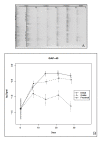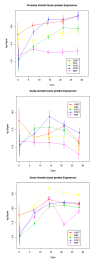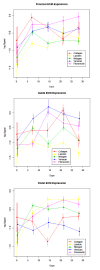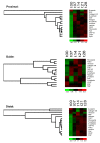Spatiotemporal expression profiling of proteins in rat sciatic nerve regeneration using reverse phase protein arrays
- PMID: 22325251
- PMCID: PMC3295716
- DOI: 10.1186/1477-5956-10-9
Spatiotemporal expression profiling of proteins in rat sciatic nerve regeneration using reverse phase protein arrays
Abstract
Background: Protein expression profiles throughout 28 days of peripheral nerve regeneration were characterized using an established rat sciatic nerve transection injury model. Reverse phase protein microarrays were used to identify the spatial and temporal expression profile of multiple proteins implicated in peripheral nerve regeneration including growth factors, extracellular matrix proteins, and proteins involved in adhesion and migration. This high-throughput approach enabled the simultaneous analysis of 3,360 samples on a nitrocellulose-coated slide.
Results: The extracellular matrix proteins collagen I and III, laminin gamma-1, fibronectin, nidogen and versican displayed an early increase in protein levels in the guide and proximal sections of the regenerating nerve with levels at or above the baseline expression of intact nerve by the end of the 28 day experimental course. The 28 day protein levels were also at or above baseline in the distal segment however an early increase was only noted for laminin, nidogen, and fibronectin. While the level of epidermal growth factor, ciliary neurotrophic factor and fibroblast growth factor-1 and -2 increased throughout the experimental course in the proximal and distal segments, nerve growth factor only increased in the distal segment and fibroblast growth factor-1 and -2 and nerve growth factor were the only proteins in that group to show an early increase in the guide contents. As expected, several proteins involved in cell adhesion and motility; namely focal adhesion kinase, N-cadherin and β-catenin increased earlier in the proximal and distal segments than in the guide contents reflecting the relatively acellular matrix of the early regenerate.
Conclusions: In this study we identified changes in expression of multiple proteins over time linked to regeneration of the rat sciatic nerve both demonstrating the utility of reverse phase protein arrays in nerve regeneration research and revealing a detailed, composite spatiotemporal expression profile of peripheral nerve regeneration.
Figures






References
LinkOut - more resources
Full Text Sources
Research Materials

